Charles Lock Eastlake
Sir Charles Lock Eastlake PRA (17 November 1793 – 24 December 1865) was an English painter, gallery director, collector and writer of the early 19th century.
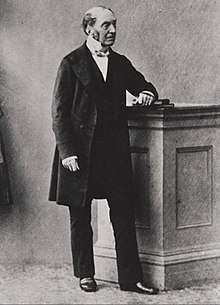
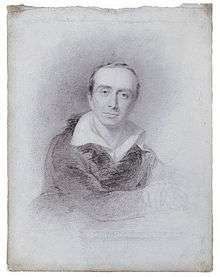
Life
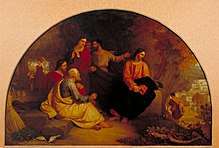
Eastlake was born in Plymouth, Devon, the fourth son of an Admiralty lawyer. He was educated at local grammar schools in Plymouth and, briefly, at Charterhouse (then still in London).[2] He was committed to becoming a painter, and in 1809 he became the first pupil of Benjamin Haydon and a student at the Royal Academy schools in London — where he later exhibited.
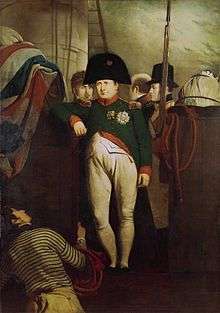
However, his first exhibited work was shown at the British Institution in 1815, a year in which he also visited Paris and studied works in the Louvre (then known as the Musée Napoléon). His first notable success was a painting Napoleon on Board the Bellerophon in Plymouth Sound (1815; National Maritime Museum, London). Like many other people at the time, Eastlake had hired a boat to take him to the ship on which Napoleon was held captive in Plymouth harbour. He sketched him from the boat.
In 1816, he travelled to Rome where he painted members of the British elite staying in Italy including fellow artists Sir Thomas Lawrence and J. M. W. Turner. He also travelled to Naples and Athens.
Despite being based predominantly in mainland Europe, Eastlake regularly sent works back to London to be exhibited, and in 1827 he was elected a member of the Royal Academy. Three years later, he returned to England permanently where he continued to paint historic and biblical paintings set in Mediterranean landscapes.
As an art scholar, he translated Goethe's Zur Farbenlehre (Theory of Colours, 1840).[3][4] He edited with extensive and valuable notes the 'Handbuch der Geschichte der Malerei (Handbook of the History of Painting) by Franz Kugler, which in its first English version was translated by 'A Lady', Mrs. Margaret Hutton. These publications and Eastlake's reputation as an artist led to his nomination in 1841 to become secretary of the Fine Arts Commission, the body in charge of government art patronage. He set up home in Fitzroy Square. [5]
In his On Vision and Colors, § 14, Schopenhauer praised Eastlake's translation of Goethe.
Eastlake, the painter and gallery inspector, furnished his countrymen, in 1840, with such an excellent translation of Goethe's theory of color that it is a perfect reproduction of the original and reads more easily; in fact, it is understood more easily than the original.
Having already advised the National Gallery, London on acquisitions, he was appointed the Gallery's second Keeper in 1843, a post he later resigned to resume writing and painting.[6] In 1845, he was elected into the National Academy of Design as an Honorary Academician.
In 1849 he married Elizabeth Rigby, an art historian and translator of German art histories, forming a formidable art history writing partnership.[6]
From 1850–1865, he was the second president of the Birmingham Society of Artists.[7] Elected President of the Royal Academy and knighted in 1850, he became a notable figure in the British art establishment, being appointed the first President of the Photographic Society in 1853 and, in 1855, the first Director of the National Gallery. His directorship was marred by the signal failure of the National Gallery to fulfill the terms of the bequest of J.M.W.Turner, his erstwhile friend. Cambridge University awarded him an honorary degree in 1864.[8]
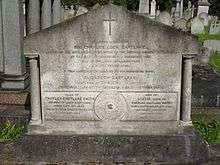
Legacy
Eastlake died in Pisa, Italy, on Christmas Eve 1865, and is buried at Kensal Green Cemetery, London.[9] His will provided for the Gallery to purchase his own collection of paintings. Lady Eastlake sold her husband's art history book collection to the Gallery's library.
Publications
- Materials for a History of Oil Painting (1847). A second volume was published posthumously in 1869.
- Contributions to the Literature of the Fine Arts (1848).
- "Hints on Household Taste" (1874)
See also
- On Vision and Colors
References
- Sir Charles Lock Eastlake, National Portrait Gallery, London, NPG 3944(22), 17 July 2013. Retrieved 17 July 2013.
- Monkhouse 1885, p. 330.
- Introduction to Goethe's Theory of Colours
- Goethe's Theory of Colours: Translated from the German; with Notes by Charles Lock Eastlake, R.A., F.R.S. London: John Murray. 1840. Retrieved 18 October 2017 – via Internet Archive.
- "Fitzroy Square Pages 52-63 Survey of London: Volume 21, the Parish of St Pancras Part 3: Tottenham Court Road and Neighbourhood. Originally published by London County Council, London, 1949". British History Online. Retrieved 4 August 2020.
- Rossetti 1911.
- Anon (1933). "The Spring Exhibition, 1933 (catalogue)". RBSA. Cite journal requires
|journal=(help) - "Eastlake, Charles Lock (ESTK864CL)". A Cambridge Alumni Database. University of Cambridge.
- Monkhouse 1885, p. 333.
- Attribution
- Monkhouse, William Cosmo (1885–1900). . Dictionary of National Biography. London: Smith, Elder & Co. pp. 330–333. ; Endnotes:
- Memoir by Lady Eastlake prefixed to the second series of Contributions to the Literature of the Fine Arts
- Pictures by Sir Charles Eastlake
- Haydon's Autobiography
- Catalogue of the National Gallery (Wornum), and books mentioned in the text.
- Rossetti, William Michael (1911). . In Chisholm, Hugh (ed.). Encyclopædia Britannica (11th ed.). Cambridge University Press.
External links
| Wikimedia Commons has media related to Charles Lock Eastlake. |
- 28 paintings by or after Charles Lock Eastlake at the Art UK site
- Works by Charles Lock Eastlake at Project Gutenberg
- Works by Charles Lock Eastlake at LibriVox (public domain audiobooks)

- Works by or about Charles Lock Eastlake at Internet Archive
- "Archival material relating to Charles Lock Eastlake". UK National Archives.

| Cultural offices | ||
|---|---|---|
| Preceded by Sir Martin Archer Shee |
President of the Royal Academy 1850–1865 |
Succeeded by Francis Grant |